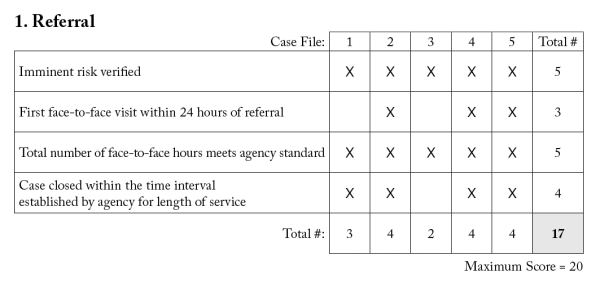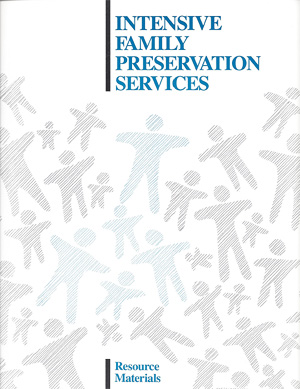2014, the 40th Anniversary of Intensive Family Preservation Services is drawing to a close. This year has been an opportunity to look back at the beginning of Intensive Family Preservation Services, trace its growth, understand its incredible impact on child welfare and see where it is today.
2015 begins the next chapter of IFPS. We hope you join us on the IFPS Website and IFPS Blog as we document what IFPS is doing, where it is going and what we are learning.
IFPS 40TH ANNIVERSARY CELEBRATION
 In July present and past leaders in the IFPS movement from many national organizations (including Annie E. Casey Foundation, Childr
In July present and past leaders in the IFPS movement from many national organizations (including Annie E. Casey Foundation, Childr en’s Defense Fund, Child Welfare League of America, National Conference of State Legislators, Edna McConnell Clark Foundation, National Council of Juvenile and Family Court Judges) and from many states (Indiana, Louisiana, New Jersey, New York, Kentucky, Missouri, Washington) gathered in Seattle to celebrate and chronicle the history and stories of one of the most important systems reform init
en’s Defense Fund, Child Welfare League of America, National Conference of State Legislators, Edna McConnell Clark Foundation, National Council of Juvenile and Family Court Judges) and from many states (Indiana, Louisiana, New Jersey, New York, Kentucky, Missouri, Washington) gathered in Seattle to celebrate and chronicle the history and stories of one of the most important systems reform init iatives in child welfare in this country.
iatives in child welfare in this country.
Attendees shared their knowledge and experiences as the group reviewed the contribution of IFPS to child welfare, how its implementation impacted child welfare, and what it offers for the future.
 Charlotte Booth, Executive Director of the Institute for Family Development opened the IFPS 40th anniversary celebration with a welcome and shared why the IFPS initiative is so significant in child welfare:
Charlotte Booth, Executive Director of the Institute for Family Development opened the IFPS 40th anniversary celebration with a welcome and shared why the IFPS initiative is so significant in child welfare:
“We are here today to celebrate and document the most brilliantly conceived and executed system change effort I have ever seen, let alone had the honor of being part of. In fact, while I’ve been calling it an “initiative,” that’s not quite the right word. Revolution or reformation might better express the magnitude of what was done.”
She explained that this day was an opportunity to see how all the different aspects of the initiative wove together and the outcomes that make family preservation what it is today: “…we want to document this information not just to paint a picture of the past, but to create a blueprint for the new generation of child welfare leaders and policy makers…”
IFPS 40th Anniversary Remarks by Charlotte Booth
Peter Forsythe, Children’s Program Director at the Edna McConnell Clark Foundation provided leadership for the intensive family preservation initiative. Between 1985 and 1995 the Edna McConnell Clark Foundation supported intensive family preservation services helping more than 30 states adopt the Homebuilders™ model.
Peter Forsythe attended the 40th Anniversary and had this reaction: “I sat with wonder today  as I let you guys catch me up on 20 years of time in the hills and being unconnected with what’s gone on since I retired from the Clark Foundation, and it was a marvelous day to have a chance to learn these things, and I marvel at the strength and the creativity and the resilience of this team that you guys are…[This] cause has gone forward, and I’m just incredibly proud of what you have continued to do.”
as I let you guys catch me up on 20 years of time in the hills and being unconnected with what’s gone on since I retired from the Clark Foundation, and it was a marvelous day to have a chance to learn these things, and I marvel at the strength and the creativity and the resilience of this team that you guys are…[This] cause has gone forward, and I’m just incredibly proud of what you have continued to do.”
THE INTENSIVE FAMILY PRESERVATION SERVICES WEBSITE
www.intensivefamilypreservation.org

The IFPS website was launched at the July celebration. The website is designed as a resource for those interested and working in IFPS. It archives IFPS’ history and will continue to document its growth and impact.
The website includes key resources for IFPS, including a comprehensive bibliography and the 2014 Nationwide IFPS Survey Report. http://www.intensivefamilypreservation.org/resources
You can also read more about the July 40th Anniversary Celebration and see photos from the event. http://www.intensivefamilypreservation.org/resources
IFPS BLOG
www.intensivefamilypreservation.org/blog
Throughout the year the IFPS blog has highlighted both the history and the future of IFPS. Posts have covered IFPS Practice, Research, State Profiles, IFPS in Mental Health and Juvenile Justice.
Pioneers and experts in the field of family preservation services shared their thoughts, memories and wisdom—excerpted here with links to their full posts:
Jim Whittaker, Professor Emeritus, University of Washington School of Social Work:
 “What then are the defining characteristics/components of intensive family preservation services? The first is a set of values and beliefs. Variously stated and as referenced earlier, they all speak to the notion of “family” as the ideal locus for child rearing and family support. Parents are viewed collegially, crises are viewed as opportunities for change, families are presumed to be doing the best they can under difficult circumstances, and caution is urged in labeling families as untreatable. While this particular set of values originates from the Homebuilders program, perhaps the best known of all of the family preservation models, the expressed values reflect the larger and more diverse array of family preservation programs as well.”
“What then are the defining characteristics/components of intensive family preservation services? The first is a set of values and beliefs. Variously stated and as referenced earlier, they all speak to the notion of “family” as the ideal locus for child rearing and family support. Parents are viewed collegially, crises are viewed as opportunities for change, families are presumed to be doing the best they can under difficult circumstances, and caution is urged in labeling families as untreatable. While this particular set of values originates from the Homebuilders program, perhaps the best known of all of the family preservation models, the expressed values reflect the larger and more diverse array of family preservation programs as well.”
The Elegant Simplicity of Family Preservation Practice Legacies and Lessons
Judge Richard Fitzgerald:
 “As I became aware of the work of The Institute for Family Development and the Homebuilders® model I saw the model as a powerful tool to meet the constitutional requirement of “reasonable efforts” and I spent time training judges about the model. The State’s interest in child protection which requires action abuts fundamental parental rights. While I may at times have been guilty of overselling the concepts of Peter Peccora and Charlotte Booth and the usual suspects who taught me and are gathered there today, I have no mea culpa as I saw in my own community and across systems the benefits to families of keeping families together by removing the risk rather than the child.”
“As I became aware of the work of The Institute for Family Development and the Homebuilders® model I saw the model as a powerful tool to meet the constitutional requirement of “reasonable efforts” and I spent time training judges about the model. The State’s interest in child protection which requires action abuts fundamental parental rights. While I may at times have been guilty of overselling the concepts of Peter Peccora and Charlotte Booth and the usual suspects who taught me and are gathered there today, I have no mea culpa as I saw in my own community and across systems the benefits to families of keeping families together by removing the risk rather than the child.”
Judge Richard (Fitz) Fitzgerald: Reflections on the Intensive Family Preservation Initiative
Shelley Leavitt:
“I n 1994, Priscilla Martens, Director of the National Family Preservation Network (NFPN), surveyed states to gather information about statewide implementation of Intensive Family Preservation Services (IFPS). Some of you may recall that at one time, these services were called “family preservation services”—FPS, and then later (I can’t recall when), the “I”—Intensive” was added and these services became Intensive Family Preservation Services (IFPS). In some states these services are still referred to as “family preservation”, and in others, “intensive family preservation”.
n 1994, Priscilla Martens, Director of the National Family Preservation Network (NFPN), surveyed states to gather information about statewide implementation of Intensive Family Preservation Services (IFPS). Some of you may recall that at one time, these services were called “family preservation services”—FPS, and then later (I can’t recall when), the “I”—Intensive” was added and these services became Intensive Family Preservation Services (IFPS). In some states these services are still referred to as “family preservation”, and in others, “intensive family preservation”.
In 1994, the survey showed that a half dozen states had implemented IFPS/FPS statewide. This was pretty amazing. After a fairly short time—less than 8 years—statewide implementation was achieved in a number of states. This accomplishment was the direct result of Peter Forsythe’s vision and strategic approach to systems change, and the work of many of you here today, who were involved at many different levels.”
Shelley Leavitt: What’s Happening Today in IFPS and HOMEBUILDERS®
http://www.intensivefamilypreservation.org/shelley-leavitt-whats-happening-today-in-ifps-and-homebuilders
Betsy Cole:
“An yone who has ever done cutting edge work knows that it takes courage. You face your own doubts and some very hostile critics. I praise you for your strength. In the end, I suspect that strength comes from the knowledge that you are “Doing the right thing”. And doing it not for you but for others.”
yone who has ever done cutting edge work knows that it takes courage. You face your own doubts and some very hostile critics. I praise you for your strength. In the end, I suspect that strength comes from the knowledge that you are “Doing the right thing”. And doing it not for you but for others.”
Elizabeth (Betsy) S. Cole: What Family Preservation Services Mean To Me
Posted by Peg Marckworth

 In 1980 Congress passed the Adoption Assistance and Child Welfare Act in response to findings that child welfare agencies removed children from their parents without first attempting to preserve the family and then failed to provide parents with adequate services for reunification. The new law required states (child welfare agencies) to make “reasonable efforts” to help families stay together or to help reunite them. Congress required courts to make a finding as to whether or not the child welfare agency provided reasonable efforts. If the court made a “no reasonable efforts” finding, then the agency would receive no federal funding while the child was in foster care.
In 1980 Congress passed the Adoption Assistance and Child Welfare Act in response to findings that child welfare agencies removed children from their parents without first attempting to preserve the family and then failed to provide parents with adequate services for reunification. The new law required states (child welfare agencies) to make “reasonable efforts” to help families stay together or to help reunite them. Congress required courts to make a finding as to whether or not the child welfare agency provided reasonable efforts. If the court made a “no reasonable efforts” finding, then the agency would receive no federal funding while the child was in foster care.

 In July present and past leaders in the IFPS movement from many national organizations (including Annie E. Casey Foundation, Childr
In July present and past leaders in the IFPS movement from many national organizations (including Annie E. Casey Foundation, Childr en’s Defense Fund, Child Welfare League of America, National Conference of State Legislators, Edna McConnell Clark Foundation, National Council of Juvenile and Family Court Judges) and from many states (Indiana, Louisiana, New Jersey, New York, Kentucky, Missouri, Washington) gathered in Seattle to celebrate and chronicle the history and stories of one of the most important systems reform init
en’s Defense Fund, Child Welfare League of America, National Conference of State Legislators, Edna McConnell Clark Foundation, National Council of Juvenile and Family Court Judges) and from many states (Indiana, Louisiana, New Jersey, New York, Kentucky, Missouri, Washington) gathered in Seattle to celebrate and chronicle the history and stories of one of the most important systems reform init iatives in child welfare in this country.
iatives in child welfare in this country.
 Charlotte Booth, Executive Director of the Institute for Family Development opened the IFPS 40th anniversary celebration with a welcome and shared why the IFPS initiative is so significant in child welfare:
Charlotte Booth, Executive Director of the Institute for Family Development opened the IFPS 40th anniversary celebration with a welcome and shared why the IFPS initiative is so significant in child welfare: as I let you guys catch me up on 20 years of time in the hills and being unconnected with what’s gone on since I retired from the Clark Foundation, and it was a marvelous day to have a chance to learn these things, and I marvel at the strength and the creativity and the resilience of this team that you guys are…[This] cause has gone forward, and I’m just incredibly proud of what you have continued to do.”
as I let you guys catch me up on 20 years of time in the hills and being unconnected with what’s gone on since I retired from the Clark Foundation, and it was a marvelous day to have a chance to learn these things, and I marvel at the strength and the creativity and the resilience of this team that you guys are…[This] cause has gone forward, and I’m just incredibly proud of what you have continued to do.”
 “What then are the defining characteristics/components of intensive family preservation services? The first is a set of values and beliefs. Variously stated and as referenced earlier, they all speak to the notion of “family” as the ideal locus for child rearing and family support. Parents are viewed collegially, crises are viewed as opportunities for change, families are presumed to be doing the best they can under difficult circumstances, and caution is urged in labeling families as untreatable. While this particular set of values originates from the Homebuilders program, perhaps the best known of all of the family preservation models, the expressed values reflect the larger and more diverse array of family preservation programs as well.”
“What then are the defining characteristics/components of intensive family preservation services? The first is a set of values and beliefs. Variously stated and as referenced earlier, they all speak to the notion of “family” as the ideal locus for child rearing and family support. Parents are viewed collegially, crises are viewed as opportunities for change, families are presumed to be doing the best they can under difficult circumstances, and caution is urged in labeling families as untreatable. While this particular set of values originates from the Homebuilders program, perhaps the best known of all of the family preservation models, the expressed values reflect the larger and more diverse array of family preservation programs as well.” “As I became aware of the work of The Institute for Family Development and the Homebuilders® model I saw the model as a powerful tool to meet the constitutional requirement of “reasonable efforts” and I spent time training judges about the model. The State’s interest in child protection which requires action abuts fundamental parental rights. While I may at times have been guilty of overselling the concepts of Peter Peccora and Charlotte Booth and the usual suspects who taught me and are gathered there today, I have no mea culpa as I saw in my own community and across systems the benefits to families of keeping families together by removing the risk rather than the child.”
“As I became aware of the work of The Institute for Family Development and the Homebuilders® model I saw the model as a powerful tool to meet the constitutional requirement of “reasonable efforts” and I spent time training judges about the model. The State’s interest in child protection which requires action abuts fundamental parental rights. While I may at times have been guilty of overselling the concepts of Peter Peccora and Charlotte Booth and the usual suspects who taught me and are gathered there today, I have no mea culpa as I saw in my own community and across systems the benefits to families of keeping families together by removing the risk rather than the child.”
 yone who has ever done cutting edge work knows that it takes courage. You face your own doubts and some very hostile critics. I praise you for your strength. In the end, I suspect that strength comes from the knowledge that you are “Doing the right thing”. And doing it not for you but for others.”
yone who has ever done cutting edge work knows that it takes courage. You face your own doubts and some very hostile critics. I praise you for your strength. In the end, I suspect that strength comes from the knowledge that you are “Doing the right thing”. And doing it not for you but for others.”

 I have been asked to talk briefly about what is happening today in IFPS and Homebuilders®. Those of you who know me—and many of you do—know that being brief is not my strong suit, but I will try very hard to briefly summarize the current state of IFPS/Homebuilders and some of the exciting new developments.
I have been asked to talk briefly about what is happening today in IFPS and Homebuilders®. Those of you who know me—and many of you do—know that being brief is not my strong suit, but I will try very hard to briefly summarize the current state of IFPS/Homebuilders and some of the exciting new developments. I first learned about Family Preservation Services in the early 1980’s while I was at the Child Welfare League of America working on projects focused on Adoption and Permanency Planning. I was elated and skeptical at the same time. I cheered at the immediate (within 24 hours) response to referrals, concern for the child’s safety and the focus on the family as a unit and their relationship to the community and that the services would be given in that home and community. It made so much sense for the worker to be there day and night. And yes, how could they do this if they didn’t have a caseload of two. How great it would be to have an in depth evaluation by skilled staff who had seen first-hand how the family functions. Wouldn’t this satisfy all the courts that wanted more? But I didn’t know how much you could really accomplish with our families in two months. These were the kinds of families we had seen for years of continuous non-service. Could episodic help really help? Did families get referred on?
I first learned about Family Preservation Services in the early 1980’s while I was at the Child Welfare League of America working on projects focused on Adoption and Permanency Planning. I was elated and skeptical at the same time. I cheered at the immediate (within 24 hours) response to referrals, concern for the child’s safety and the focus on the family as a unit and their relationship to the community and that the services would be given in that home and community. It made so much sense for the worker to be there day and night. And yes, how could they do this if they didn’t have a caseload of two. How great it would be to have an in depth evaluation by skilled staff who had seen first-hand how the family functions. Wouldn’t this satisfy all the courts that wanted more? But I didn’t know how much you could really accomplish with our families in two months. These were the kinds of families we had seen for years of continuous non-service. Could episodic help really help? Did families get referred on?